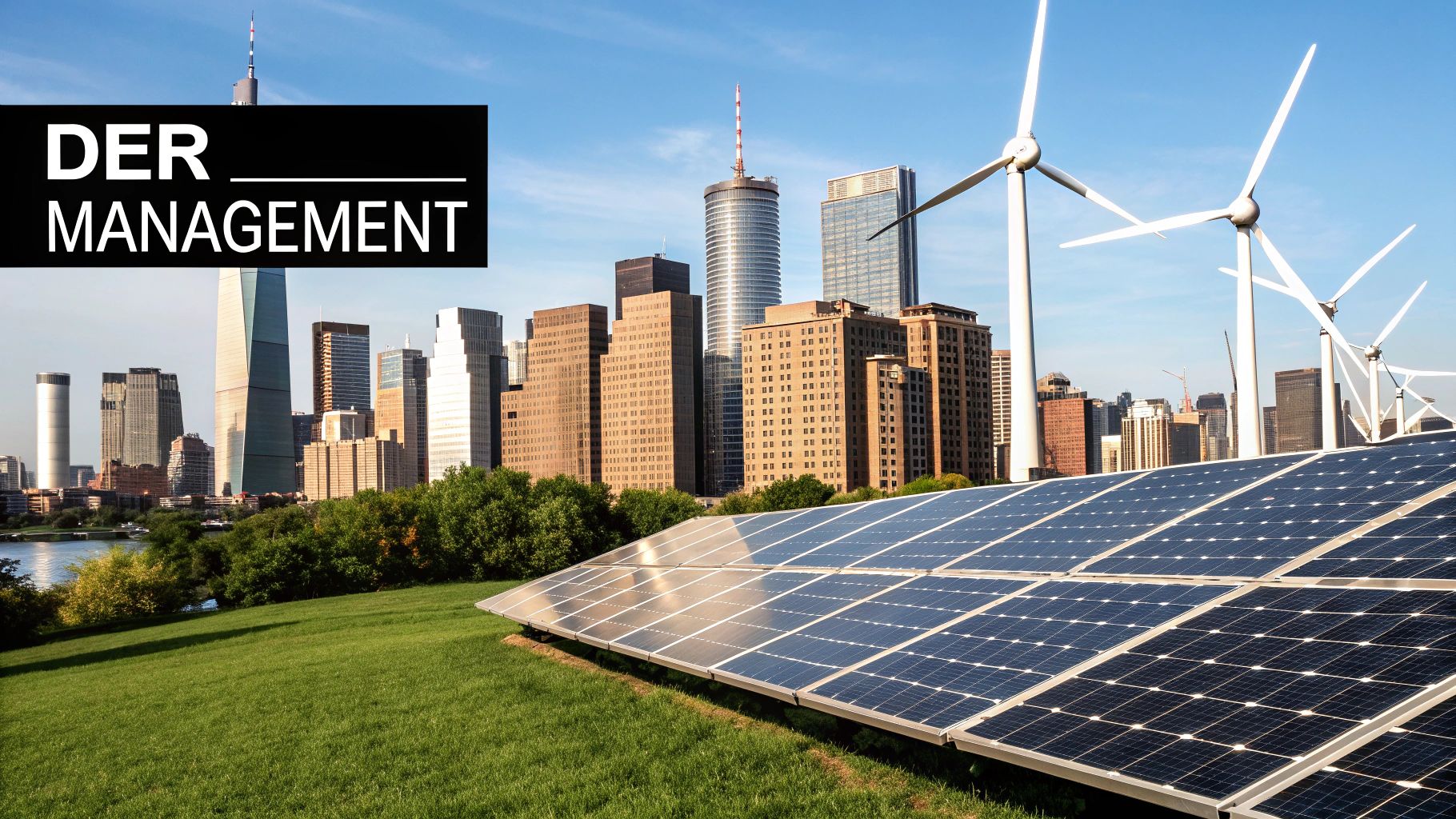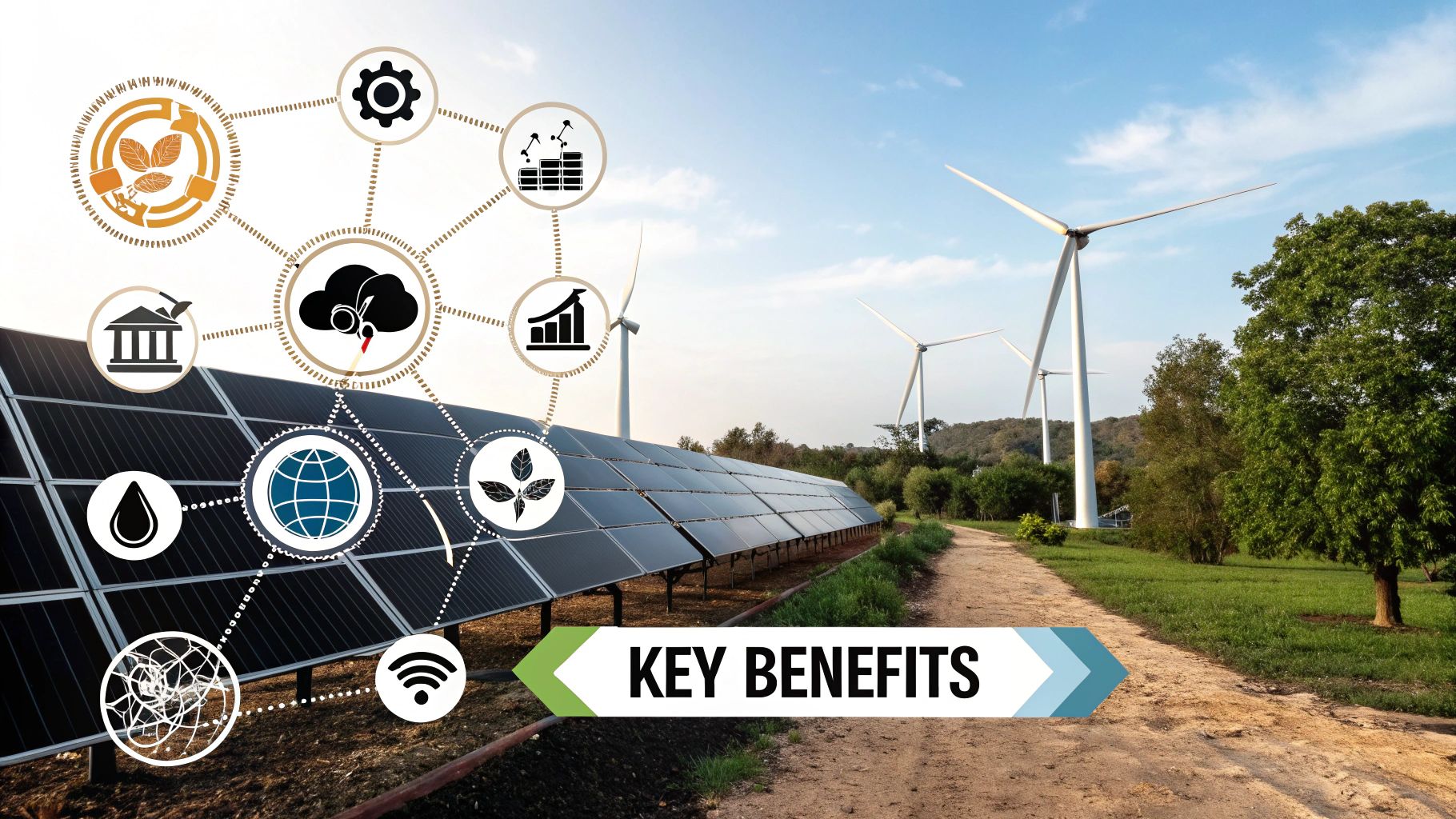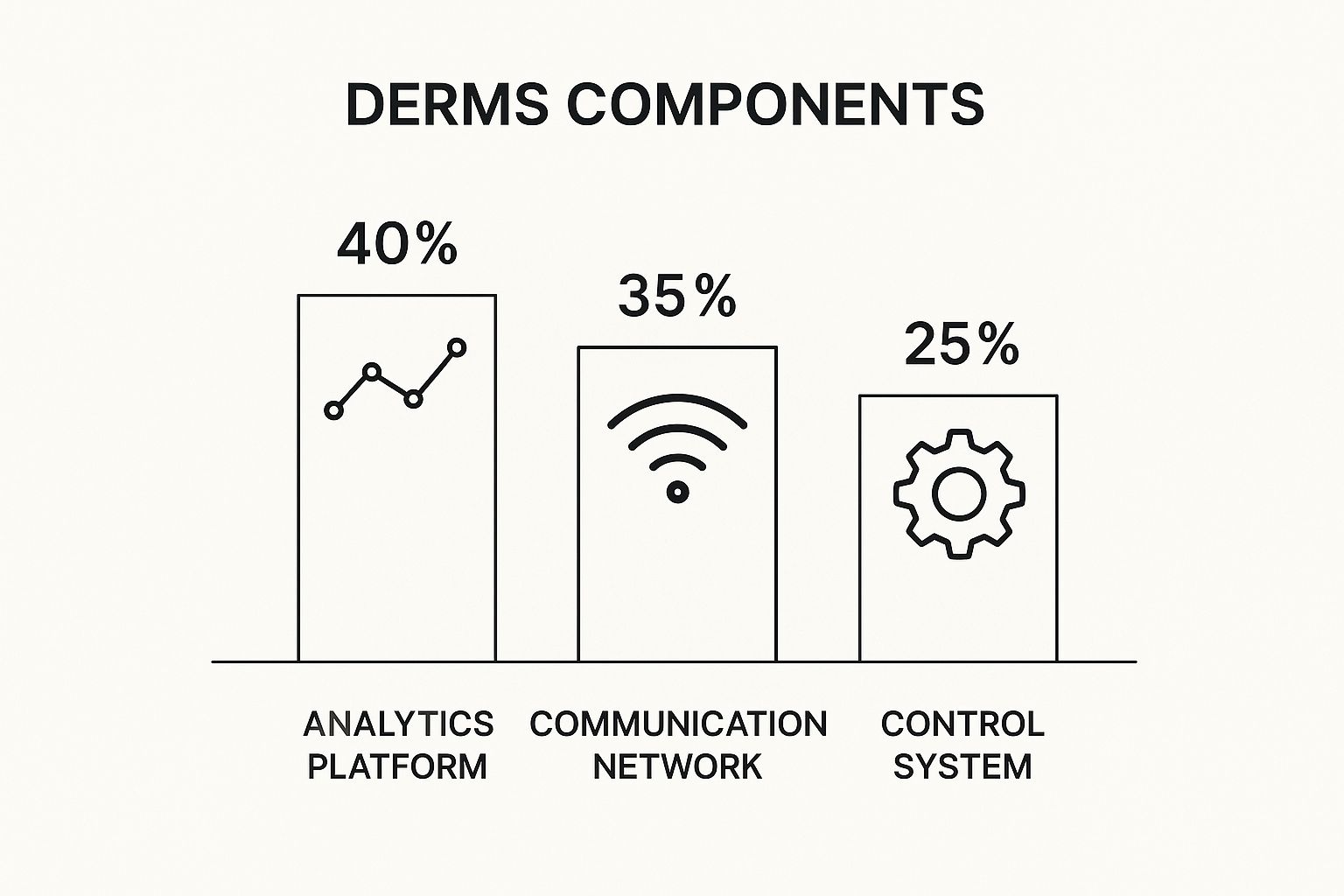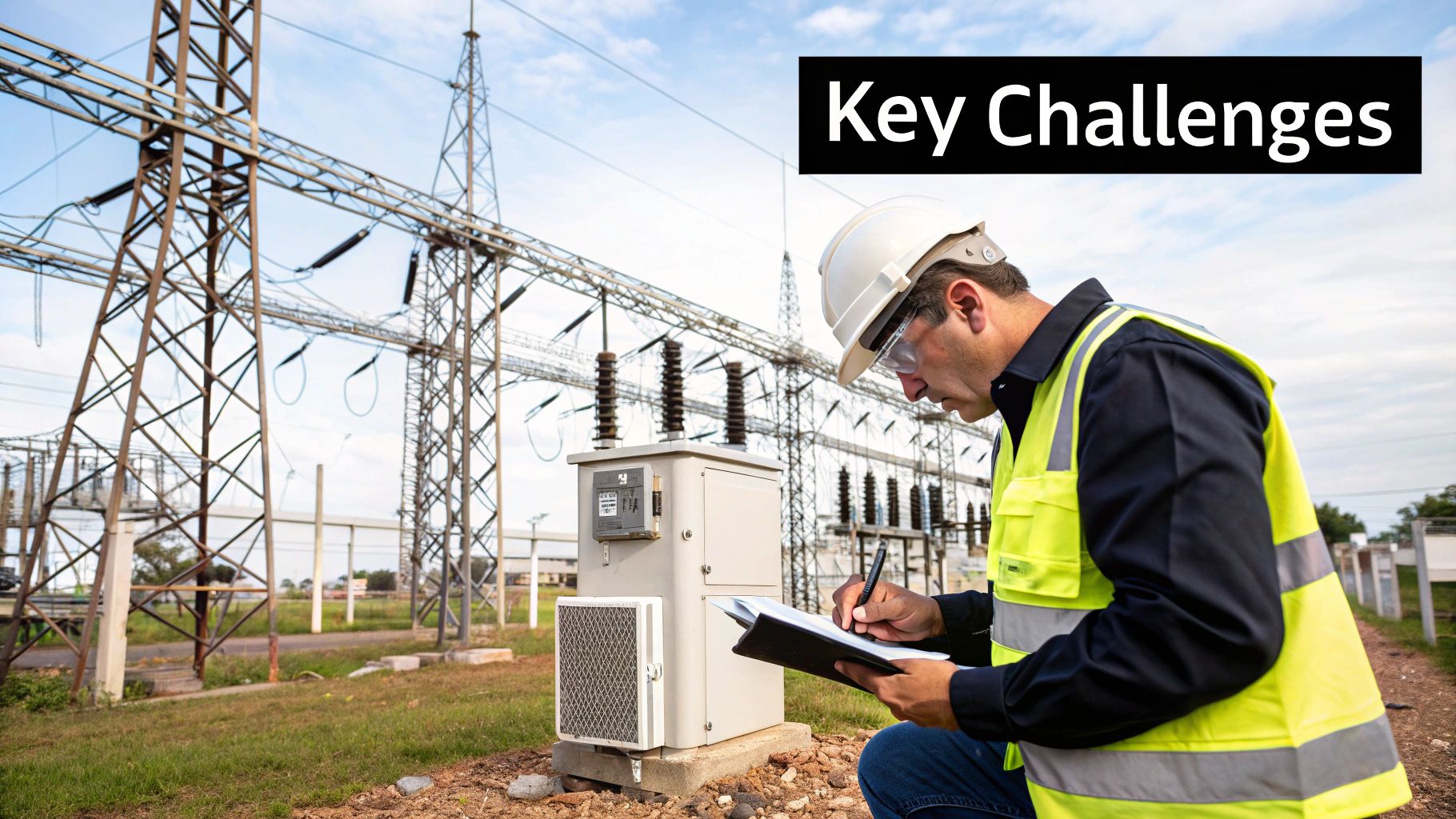
A Practical Guide to Distributed Energy Resource Management
For Installers, EPCs, Developers, and Facility Managers: This guide provides actionable, real-world solutions for integrating and managing Distributed Energy Resources (DERs). It cuts through the jargon to deliver a clear decision-making framework for sizing, brand selection, compliance, and generating ROI from modern energy projects, addressing new codes, supply trends, and common pitfalls.
Picture a symphony conductor trying to lead thousands of individual musicians, each playing their own instrument on their own schedule. That’s a pretty good analogy for the modern electrical grid. In this chaotic orchestra, Distributed Energy Resource Management (DERM) is the conductor’s baton—a sophisticated software system that brings a complex network of solar panels, battery storage, EV chargers, and generators into perfect harmony.
What Is Distributed Energy Resource Management

Distributed Energy Resource Management, or DERMS, is the central nervous system for the modern, decentralized power grid. It is a software platform built for utilities and grid operators to monitor, manage, and optimize a vast, growing network of Distributed Energy Resources (DERs).
These DERs are small-scale power generation and storage technologies located close to where electricity is used—a major departure from the old model of massive, remote power plants. For installers, EPCs, and facility managers, understanding DERs is no longer optional; it's essential for any project's success, especially with new regulations and incentives like the IRA changing the financial landscape.
Key Components of a DER Ecosystem
A DERMS platform juggles a diverse portfolio of assets. For project stakeholders, each presents unique challenges and revenue opportunities. The following table breaks down the core elements managed by a DERM system, providing a clear reference for what assets are involved and the critical considerations for each professional segment.
| DER Component | Function in the Grid | Critical Concern by ICP |
|---|---|---|
| Solar PV Systems | Generates variable power during daylight hours. | For Installers: Ensuring proper interconnection and compliance with utility communication protocols (e.g., IEEE 1547-2018). |
| Energy Storage Systems (ESS) | Stores excess energy and provides power on demand. | For Developers: Correctly sizing systems from brands like BYD and FranklinWH to maximize ROI and qualify for grid services revenue. |
| EV Chargers | Represents a significant, often unpredictable, electrical load. | For Facility Managers: Managing new demand to avoid costly peak usage charges through smart charging schedules. |
| Backup Generators | Provides essential power during grid outages. | For EPCs: Integrating units from manufacturers like Cummins for efficient, targeted use and fuel optimization. |
As you can see, each piece of the puzzle requires careful integration to function as a cohesive, revenue-generating system.
Expert Tip: A DERMS platform doesn't just see these assets; it actively controls them. It can signal batteries to discharge during peak demand, curtail solar output to prevent grid instability, or shift EV charging to off-peak hours. This is the key to unlocking their full financial and operational value.
This intelligent control is now a fundamental requirement for a stable, efficient, and resilient grid. The market's rapid growth tells the story: the global distributed energy resource management system market is projected to skyrocket from $672.56 million to nearly $1.87 billion by 2032. This explosive growth is driven by massive renewable energy deployment and critical grid modernization efforts. You can discover more about these market trends and their drivers here.
The Architecture of a Modern DERMS Platform

To master distributed energy resource management, you must understand its architecture. A DERMS isn’t a magic black box; it’s a coordinated system of hardware and software giving grid operators visibility and control. For installers and EPCs, understanding this architecture is essential for planning, specifying, and deploying successful, bankable projects.
The system is a pyramid: physical assets in the field form the base, feeding data through communication networks to the central software platform at the top, which sends control signals back down.
The Hardware Layer at the Grid Edge
The foundation of any DERMS is the hardware installed at customer sites. These devices are the system's eyes, ears, and hands, physically interacting with the grid.
For an installer, knowing these components is crucial for a smooth, code-compliant installation. For developers, selecting the right hardware is the first step toward a scalable and profitable project.
Key hardware components include:
- Smart Inverters: The brains of any solar or storage system. Modern smart inverters from brands like Sungrow and Fronius actively manage power factor, voltage, and frequency. This is a non-negotiable requirement under modern grid codes like IEEE 1547-2018 for DERMS participation.
- IoT Sensors and Meters: You can't manage what you don't measure. High-precision, revenue-grade meters are installed on DERs to deliver real-time data on energy production, consumption, and battery state of charge.
- Communication Gateways: These on-site devices act as translators, gathering data from different assets (which may use protocols like SunSpec Modbus) and securely transmitting it to the central platform using standardized protocols like IEEE 2030.5.
The Central Software and Analytics Platform
All field data flows into a central software platform, the command center where operators monitor resources and execute control strategies. This is where the heavy lifting of forecasting, optimization, and dispatch occurs.
Critical Mistake to Avoid: Viewing the platform as just a dashboard. It's an optimization engine that uses AI to predict load, forecast generation, and determine the most economically efficient way to dispatch resources to meet grid needs or capture market revenue.
This platform gives utilities and asset aggregators the key to unlocking community resources, allowing them to shift load during peak demand. For EPCs and developers, the choice of a DERMS platform determines the system's ability to scale and generate revenue through grid services.
Ensuring Scalability and Security
As DER fleets grow from hundreds to thousands of assets, the architecture must handle expansion without failure. This means using cloud-native technologies that manage massive data volumes.
Compliance Watchout: Every communication point, from the field gateway to the cloud platform, must be secured against cyber threats. Adhering to strict cybersecurity protocols isn't just a best practice; it's a core requirement for any utility-grade distributed energy resource management system.
This technical foundation, built on compliant hardware and a robust software platform, makes modern grid control a reality.
Core Benefits for Every Project Stakeholder
A successful Distributed Energy Resource Management (DERM) strategy creates real, measurable value for every stakeholder—from the developer seeking financing to the facility manager battling peak demand charges.
The numbers prove it. The market, valued at around $0.55 billion, is projected to hit $0.64 billion in 2025 and more than double to $1.2 billion by 2029—a compound annual growth rate of roughly 17.0%. This isn't hype; it's a clear signal that DERMS are essential infrastructure. You can read the full research on this expanding market.

The value of a DERM system is shared, but the specific wins vary by role. This matrix breaks down how DERM delivers tangible results for key stakeholders.
DERM Benefit Matrix by Stakeholder
| Stakeholder (ICP) | Primary Financial Benefit | Primary Operational Benefit | Key PES Solution |
|---|---|---|---|
| Project Developer/EPC | Creating new grid services revenue streams from aggregated assets. | Simplifying compliance with mandates like CA Title 24 and IRA. | PES VPP Platform |
| Facility Manager/C&I | Slashing or eliminating peak demand charges via automated dispatch. | Achieving automated energy resilience and business continuity. | PES C&I Solution |
| Homeowner | Reducing monthly utility bills via intelligent energy use and Time-of-Use arbitrage. | Gaining reliable backup power for security and peace of mind. | PES Residential Solution |
This shows how a single, integrated platform addresses unique pain points and financial goals, making a compelling case for DERM adoption.
For Facility Managers and C&I Property Owners
For C&I property managers, energy is a major operational cost. A DERMS flips that script, turning your energy system into a strategic asset.
- Slash Peak Demand Charges: The most immediate win is crushing expensive peak demand charges. A DERMS intelligently deploys on-site batteries from trusted brands like BYD during critical high-demand windows.
- Achieve Unmatched Energy Resilience: When the grid fails, a DERMS provides business continuity by automatically "islanding" your facility, switching to on-site solar and storage to keep critical operations running.
Pro Tip: Integrating EV chargers with your DERMS is a game-changer. You can offer charging as a perk without worrying about new demand spikes. The system simply schedules charging for cheaper, off-peak times.
For EPCs and Project Developers
For EPCs and developers, a DERMS unlocks new business models, shifting the conversation from a basic solar install to a high-value, grid-interactive asset.
The biggest advantage is creating new, recurring revenue streams. By controlling a fleet of DERs, you can participate in grid services programs, selling energy and capacity back to the utility. This completely changes a project's financial outlook.
- Simplified Compliance: Meeting complex rules like CA Title 24 or NYSERDA program requirements? A DERMS provides the control and reporting needed to sail through compliance.
- Enhanced Project Value: A project with DERMS capabilities is simply worth more. It's more compelling for financiers because it demonstrates a smarter, future-proof approach.
For Homeowners
For the end-user, the benefits are personal and immediate: more control over energy, budget, and security.
The first thing homeowners notice is the drop in their utility bill. A system managed by a DERM platform uses solar and battery power from brands like FranklinWH to avoid expensive peak hours. But beyond savings, it's about peace of mind. During an outage, the system takes over instantly, keeping the lights on.
A Practical Implementation Guide for Integrating DERs

Successfully integrating a mix of Distributed Energy Resources (DERs) into a cohesive system requires a practical, step-by-step framework. This guide provides an actionable roadmap for project managers and installers, from initial site assessment to final commissioning.
A methodical approach is your best defense against expensive rework and project delays.
Step-by-Step Implementation Checklist
- Site Assessment & Load Analysis: This is more than measuring a roof. It’s a deep dive into the facility's historical energy data to map peak demand, baseline usage, and critical loads. This data is the bedrock of your system design.
- System Sizing & Technology Selection: Turn raw data into a bill of materials. A factory with sharp demand spikes benefits more from a fast-responding battery from a brand like BYD or FranklinWH than a slower-to-dispatch generator.
- Procurement & Logistics: Source compatible hardware and manage delivery. Partnering with a distributor like Portlandia Electric Supply offers pre-vetted kits and bundled freight, solving major logistical headaches.
- Installation & Interconnection: Physical installation followed by navigating the utility interconnection process. Strict adherence to local codes and utility requirements is paramount.
- Commissioning & Verification: Systematically test every component and communication link. This phase validates that the system performs as designed and can be controlled by the DERMS platform.
- Ongoing Operation & Maintenance: Monitor system performance, manage assets for grid services participation, and ensure long-term reliability.
Navigating Brand Selection and Interoperability
Choosing the right brands is a critical decision. While Tier 1 manufacturers like Cummins for generators or Sungrow for inverters bring proven reliability, ensuring every component can communicate is the real challenge.
Pro Tip for Installers: Before you finalize equipment, always verify the communication protocols (like SunSpec Modbus or IEEE 2030.5) supported by each device. A mismatch can bring a project to a dead stop during commissioning. This is why Portlandia Electric Supply offers pre-vetted, compatible kits and NABCEP-certified design support to ensure your system architecture is solid from day one. For a deeper dive, explore our guide on what is an energy storage system.
The Commissioning and Verification Phase
Once installed, the commissioning process begins. This is where you test every component to confirm it performs as designed. It involves validating communication links, control functions, and safety features. A crucial part is ensuring the DERMS platform can see and control the system. As projects grow in complexity, a solid grasp of Internet of Things building automation is essential for seamless integration.
Compliance Watchout: Key NEC and UL Standards
Navigating the web of codes and standards is a major project risk. One misstep can lead to failed inspections or a utility's refusal to connect.
Keep these critical standards front and center:
- NEC Article 705 (Interconnected Electric Power Production Sources): The foundational code for any grid-tied system, spelling out safety requirements.
- UL 1741 (Standard for Inverters, Converters, Controllers and Interconnection System Equipment): The industry benchmark for smart inverters, ensuring they have grid-support functions.
- UL 9540 (Standard for Energy Storage Systems and Equipment): The primary safety standard for battery systems, covering thermal management and fire safety.
By following a structured plan and focusing on compatibility and compliance, you can sidestep major risks and deliver a high-performing DER deployment.
Navigating the Regulatory and Incentive Landscape
Deploying a Distributed Energy Resource (DER) project happens within a complex web of government policies, utility rules, and financial incentives. For developers and EPCs, mastering this landscape is about maximizing the financial potential of an asset.
The rulebook is written by federal agencies, state governments, and local utilities. The Inflation Reduction Act (IRA) has completely changed the math for DERs with tax credits and adders that significantly boost ROI.
Critical Insight: Policy isn't a roadblock; it's a financial lever. The key is strategically stacking federal incentives (IRA) with state-level rebates (NYSERDA, CA) and utility grid service payments. This can transform a project’s financial model, making an expert partner who understands these layers essential.
State Programs and Utility Rules
While federal money provides a great starting point, state-level programs define real-world opportunities. States like California (with Title 24) and New York (via NYSERDA) have created unique markets. If your project isn't aligned with these local mandates, you're leaving money on the table.
Beyond states, utilities and Independent System Operators (ISOs) set the technical rules for grid interconnection. A solid DERMS is your ticket to playing by these strict rules, giving you the control and reporting needed to participate in high-value grid services markets like frequency regulation or capacity auctions. The global market for DERs was valued at $45.65 billion and is expected to climb to $59.77 billion by 2033, fueled heavily by these policy incentives. You can discover more insights about this growing market on Global Growth Insights.
Unlocking Revenue and Ensuring Compliance
A DERMS is the Swiss Army knife for navigating this regulatory maze.
- Monetizing Grid Services: It delivers the automated control required to bid DER capacity into ancillary services markets, opening new revenue streams.
- Automating Compliance Reporting: A DERMS automatically generates the performance data and reports that utilities and incentive programs demand, eliminating administrative headaches.
- Future-Proofing Assets: Regulations change. A flexible DERMS can be updated to meet new rules, ensuring your project remains a valuable, compliant asset. This is critical as we see the future of renewable energy farming blend into the larger grid.
Mastering the regulatory landscape is a fundamental part of any winning DER management strategy, blending technical know-how, policy awareness, and the right technology platform.
How We Empower Your DERM Strategy
Successful Distributed Energy Resource Management projects are built with real hardware, tight logistics, and zero room for error. This is where Portlandia Electric Supply becomes your strategic project partner, solving the tangible friction points that derail a DERM deployment.
We bridge the gap between design and profitable operation. A successful DERM system hinges on the seamless interoperability of dozens of components. We remove the guesswork with a massive, in-stock inventory of compatible, pre-vetted hardware from industry leaders like Sungrow, FranklinWH, and Cummins. This ensures the systems you design are the systems you can build—without costly delays.
From Bid to Commissioning
We simplify the entire project lifecycle. Our NABCEP-certified design reviews validate your system architecture against key compliance standards like NEC and UL, helping you fix risks before ordering. This ensures your project is technically sound and ready for utility interconnection from day one.
For Developers & EPCs: The real-world challenges of DERM are often logistical. We solve this head-on with bundled freight and logistics management. By consolidating shipments from our nationwide distribution hubs, we ensure your materials arrive on time and on budget.
Once the design is locked, we help you build the right team. Our PowerLink service connects developers with qualified, local installers, removing a major bottleneck in project execution. This network is crucial for implementing complex solar energy solutions that form the backbone of modern DERM strategies.
Actionable Next Steps for Every Professional
Your role determines your next move. We provide clear, direct pathways to get you the exact support you need.
- For Installers: Need pricing for an upcoming job? Request a Quote for specific BOMs and get immediate access to our full inventory.
- For Developers: Planning a multi-site rollout? Contact an Expert for a comprehensive design consultation and compliance review.
- For Procurement Managers: Sourcing for a large-scale project? Submit Your Bill of Materials for a bulk quote with optimized freight.
Partnering with us means you get more than parts in a box. You get a dedicated ally invested in your project's success, from the first sketch to the final sign-off.
Common Questions About DERMS
When planning and implementing distributed energy resource strategies, stakeholders have sharp, practical questions. Here are the most common questions we hear from professionals in the field.
What Is the Difference Between a DERMS and a VPP?
It’s easy to confuse Distributed Energy Resource Management Systems (DERMS) and Virtual Power Plants (VPPs), but they have different jobs.
- A DERMS is the air traffic control system for the grid. It's the utility's operational platform to see, manage, and control all DERs in its territory. Its top priority is keeping the grid balanced, reliable, and safe.
- A VPP is like an airline. It’s a commercial fleet of aggregated DERs (e.g., solar and battery systems) bundled to act like a single power plant. Its goal is purely commercial: to sell energy or grid services to the market for profit.
Essentially, a VPP operates within the DERMS framework to participate in the market.
How Does DERM Improve Grid Resilience During Extreme Weather?
A DERMS builds a more decentralized and resilient power network, which is critical during extreme weather.
When a major storm causes a widespread outage, a DERMS can instantly "island" a microgrid or a single home with assets like FranklinWH or BYD storage. This allows the site to disconnect from the downed grid and operate independently on local solar and battery power.
This intelligent management prioritizes power for critical facilities and optimizes stored energy use, extending backup power duration. It turns a massive blackout into a manageable event by creating secure pockets of energy stability.
What Are the First Steps for an Installer to Get Started?
For solar and electrical installers breaking into DERM-ready projects, the path involves three key steps:
- Get Certified: Master the core technologies by getting certified on smart inverters and energy storage systems from leading manufacturers.
- Understand the Protocols: Learn the communication languages these systems use, such as IEEE 2030.5 and SunSpec Modbus, which are essential for DERMS integration.
- Partner with the Right Distributor: You need a partner who provides compliant hardware and offers the technical support to back it up. That's where we fit in.
At Portlandia Electric Supply, we provide access to the right hardware, offer NABCEP-certified design support to ensure projects meet utility requirements, and connect you with developers through our PowerLink service. Ready to equip your next project? Request a Quote today.
